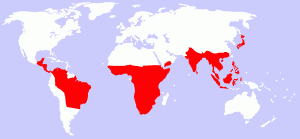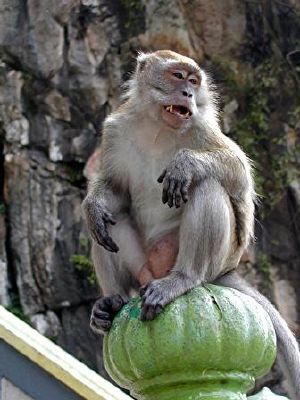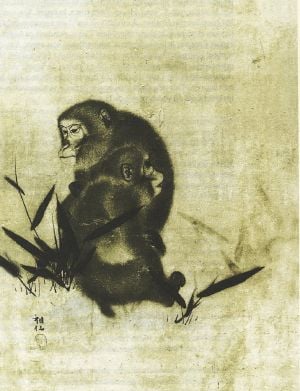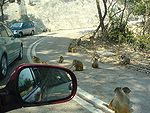Monkey
A monkey is any member of two of the three groupings of simian primates. These two groupings are the New World and Old World monkeys of which together there are 264 known extant species. Because of their similarity to monkeys, apes such as chimpanzees and gibbons are sometimes incorrectly called monkeys. Also, a few monkey species have the word "ape" in their common name. Because they are not a single coherent group, monkeys do not have any particular traits that they all share and are not shared with the remaining group of simians, the apes.
Characteristics
Monkeys range in size from the Pygmy Marmoset, at 14-16 cm (5-6 inch) long (plus tail) and 120-140 g (4-5 oz) in weight to the male Mandrill, almost 1 metre (3 ft) long and weighing 35 kg (75 lb). Some are arboreal (living in trees), some live on the savanna; diets differ among the various species but may contain any of the following: fruit, leaves, seeds, nuts, flowers, insects, spiders, eggs and small animals.
Some characteristics are shared among the groups; most New World monkeys have prehensile tails while Old World monkeys do not; some have trichromatic colour vision like that of humans, others are dichromats or monochromats. Although both the New and Old World monkeys, like the apes, have forward facing eyes, the faces of Old World and New World monkeys look very different though again, each group shares some features such as the types of noses, cheeks and rumps. To understand the monkeys, therefore, it is necessary to study the characteristics of the different groups individually.
Name
According to the Oxford English Dictionary The name "monkey" may come from a German version of the Reynard the Fox fable, published in around 1580. In this version of the fable, a character named Moneke is the son of Martin the Ape. The word Moneke may have been derived from the Italian monna, which means "a female ape". The name Moneke persisted over time likely due to the popularity of Reynard the Fox.
A group of monkeys may be referred to as a mission of monkeys or a tribe of monkeys.
Monkeys in captivity
On boats
When the British first began to explore Africa, young monkeys were often captured to provide entertainment during long voyages. Some were later transferred to domestic zoos, and in fact many modern captive monkeys in the UK are descended from individuals captured during the Napoleonic and Victorian eras. According to legend, one of the early British captive monkeys was lost at sea and washed up ashore near Hartlepool, England, where it was mistaken for a Frenchman and hanged. The people of Hartlepool have since borne the nickname "monkey hangers."
As pets
Although they may appear to be friendly and nice and can resemble human babies for some people, many people believe that monkeys should not be kept as, or seen as, pets. While baby monkeys are usually as easy to keep clean as a human infant (by diapering), monkeys that have reached puberty usually remove their diapers and cannot be toilet trained. They require constant supervision and mental stimulation. They usually require a large amount of attention. Monkeys can not handle being away from their owners for long periods of time, such as family trips for example, due to their need of attention. Bored monkeys can become extremely destructive and may even go so far as to smear or throw their own feces. There needs to be a lot of time set aside for cleaning up whatever mess the monkey might make. Most adolescent monkeys begin to bite unpredictably and pinch adults and children. Any surgical means to stem this behavior (such as removing the teeth or fingertips of the monkey) is widely considered cruel, and it is usually difficult to find veterinarians who will treat them: even exotic-animal veterinarians may not be familiar with them. Monkeys eventually have to grow up and may in most cases become wild and not easy to control. The monkeys may also become aggressive even to their owners. They can change from one minute to the next without warning making it hard for the owner to fully understand them.
While a majority of monkey owners find other homes for them, such as zoos and monkey rescues, some people report having long and rewarding relationships with monkeys. Monkeys are known to get attached to their first owner so switching from one to another would not be a good idea. It is not easy for a monkey to get used to their new environment. Monkeys need to be placed in social areas. It might be bad for the monkey to place them in non-social areas which could lead to problems. It is not cheap to bring up a monkey. It becomes very costly when it comes to buying food and housing them. Some monkeys may even have special needs such as diets.
In most large metropolitan areas in the U.S. it is illegal to keep monkeys in the home; even in places where they are legal, a Department of Agriculture permit is usually required. Their legal status as pets varies in other countries. Permits may be issued to those who qualify in the caring of monkeys.
In laboratories
Macaques, especially Rhesus monkeys, and African green monkeys are widely used in animal testing facilities. This is primarily because of their relative ease of handling, their fast reproductive cycle (compared to apes) and their psychological and physical similarity to humans. In the United States, around 50,000 non-human primates, most of them monkeys, have been used in experiments every year since 1973 [2] (pdf); 10,000 monkeys were used in the European Union in 2004. Highly sociable animals, monkeys are kept in many different environments.
Use of monkeys in laboratories is highly controversial. Many claim that the practice is cruel and produces little information of value, and there have been many protests and instances of vandalism against it. However, defenders of testing on monkeys say that it has led to many important medical breakthroughs, and that the prevention of harm to humans should be a higher priority than the harm done to monkeys. The topic has become a popular cause for animal rights groups.
Classification
The following lists shows where the various monkey families (bolded) are placed in the Primate classification. Note that the smallest grouping that contains them all is the Simiiformes, the simians, which also contains the apes. Calling apes monkeys is incorrect. Calling either a simian is correct.
- ORDER PRIMATES
- Suborder Strepsirrhini: non-tarsier prosimians
- Suborder Haplorrhini: tarsiers, monkeys and apes
- Infraorder Tarsiiformes
- Family Tarsiidae: tarsiers
- Infraorder Simiiformes: simians
- Platyrrhini: New World monkeys
- Family Cebidae: marmosets, tamarins, capuchins and squirrel monkeys (56 species)
- Family Aotidae: night monkeys, owl monkeys, douroucoulis (8 species)
- Family Pitheciidae: titis, sakis and uakaris (41 species)
- Family Atelidae: howler, spider and woolly monkeys (24 species)
- Catarrhini
- Superfamily Cercopithecoidea
- Family Cercopithecidae: Old World monkeys (135 species)
- Superfamily Hominoidea: apes
- Family Hylobatidae: gibbons ("lesser apes") (13 species)
- Family Hominidae: humans and other great apes (7 species)
- Superfamily Cercopithecoidea
- Platyrrhini: New World monkeys
- Infraorder Tarsiiformes
Monkeys in culture
Sun Wukong and Hanuman, figures prominent in Chinese mythology and Hindu mythology, respectively, are monkeys.
Monkeys are prevalent in numerous books, television programs, and movies. The television series Monkey, the literary characters Monsieur Eek and Curious George are all examples.
However, pop culture often incorrectly labels apes, particularly chimpanzees, gibbons, and gorillas, as monkeys. Terry Pratchett makes use of this trait in his Discworld novels, in which the Librarian of the Unseen University is an orangutan who gets very violent if referred to as a monkey.
Zodiac
The Monkey is the ninth in the 12-year cycle of animals which appear in the Chinese zodiac related to the Chinese calendar. The next time that the monkey will appear as the zodiac sign will be in the year 2016.
ReferencesISBN links support NWE through referral fees
- "The Impossible Housing and Handling Conditions of Monkeys in Research Laboratories", by Viktor Reinhardt, International Primate Protection League, August 2001
- Inside the monkey house at Covance, shot undercover by the British Union for the Abolition of Vivisection
- The Problem with Pet Monkeys
Credits
New World Encyclopedia writers and editors rewrote and completed the Wikipedia article in accordance with New World Encyclopedia standards. This article abides by terms of the Creative Commons CC-by-sa 3.0 License (CC-by-sa), which may be used and disseminated with proper attribution. Credit is due under the terms of this license that can reference both the New World Encyclopedia contributors and the selfless volunteer contributors of the Wikimedia Foundation. To cite this article click here for a list of acceptable citing formats.The history of earlier contributions by wikipedians is accessible to researchers here:
The history of this article since it was imported to New World Encyclopedia:
Note: Some restrictions may apply to use of individual images which are separately licensed.



